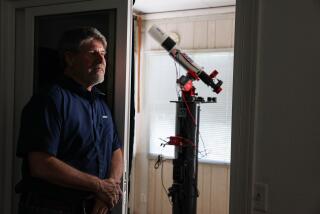Could supernovas have altered the development of life on Earth?
- Share via
Scientists sifting through rare isotopic signatures in Earth’s crust beneath the sea have found a signal from the heavens: evidence of nearby supernova explosions in just the last few million years.
The discoveries, described in the journal Nature, shed light on the impact that such stellar deaths can have on our home planet, and may help scientists understand whether or not these events have affected the course of life on Earth.
Supernovas are the powerful, violent deaths of massive stars, whose deaths seed the rest of the universe with heavy elements that aren’t made otherwise. So while supernovas have helped seed other stars and their planets with rarer elements, astronomers have long wondered what would happen if such fireworks went off a little too close to our planetary home.
“For more than half a century, astronomers have speculated that supernovae have occurred close enough to Earth to affect the planet, possibly contributing to mass extinctions or climate,” Adrian Melott of the University of Kansas, who was not involved in the study, wrote in a commentary on the paper.
But how do you find hints of a long-passed supernova’s effects on Earth? In recent years, scientists have realized that they can track the iron isotope iron-60, which, unlike its lighter, more stable cousin Fe-56, most likely came from a supernova. (Because iron-60 has a half-life of just 2.6 million years, any that’s found on Earth can’t have originated in our planet’s formation.)
Using this isotopic evidence, two independent studies in Nature sought to pin down any relatively recent supernovae that might have left their mark on Earth. In a paper led by Anton Wallner of Australian National University, the scientists gathered deep-sea sediment samples from the crust beneath the Pacific, Atlantic and Indian oceans.
The researchers found iron-60’s presence in two spans, from 3.2 million to 1.7 million years ago and from 8.7 million to 6.5 million years ago. Those extended periods hint that there might have been a series of supernovas that were showering Earth with debris, or that our solar system was passing through an interstellar neighborhood that was highly “polluted” by supernova debris.
Either way, both these periods also just happened to overlap with significant climate changes, they added – particularly the more recent one, which matched up with the onset of the little ice age.
“Interestingly, the older event coincides with a strong increase in 3He and temperature change at about 8 [million years] ago, while the more recent activity starting about 3 [million years] ago occurred at the same time as Earth’s temperature started to decrease during the Plio–Pleistocene transition,” the study authors wrote.
In the second paper, led by Dieter Breitschwerdt of the Berlin Institute of Technology, scientists calculated the possible trajectory of these supernovas based on the isotopic signature on Earth. They found that the iron-60 signal lines up with a pair of supernova explosions between 90 and 100 parsecs (or 293.5 to 326 light-years) away. The closer of the two stars held the mass of 9.2 suns and went supernova about 2.3 million years ago, while the farther one weighed in at 8.8 solar masses and exploded just 1.5 million years ago.
Luckily for Earth, these supernovas are well outside the calculated kill-distance of about 8 parsecs (or around 26 light-years), where such an explosion would be bad news for life. Still, as the new papers show, these more distant explosions were still close enough to deposit something into Earth’s crust.
Take the more recent supernova period identified by Wallner and colleagues, which matches up with the Pliocene-Pleistocene boundary – right around when the most recent Ice Age was swinging into full, frigid force.
“We do not know if there is a link between supernova activity and colder temperature,” Melott said. However, he added, “This climatic variation may be one of the conditions that led to human evolution. Ionization of the atmosphere by supernovae may also lead to an increase in lightning and possibly other climatic effects.”
These open questions, however, will have to wait to be answered by further study.
Follow @aminawrite on Twitter for more science news and “like” Los Angeles Times Science & Health on Facebook.
ALSO
Hot nights, scorching days: Extreme super Earth baffles astronomers
Hot Jupiter! Astronomers discover giant planet with three shining suns
Scientists are sending fungi into space in the hope of developing new medicines







